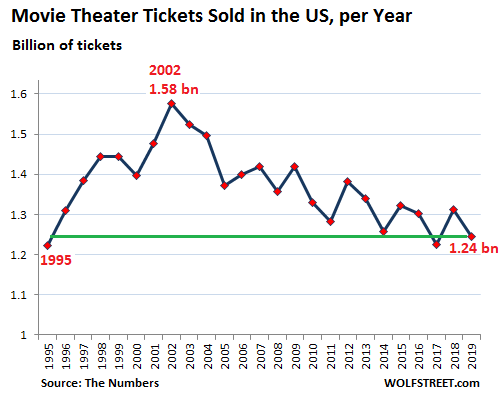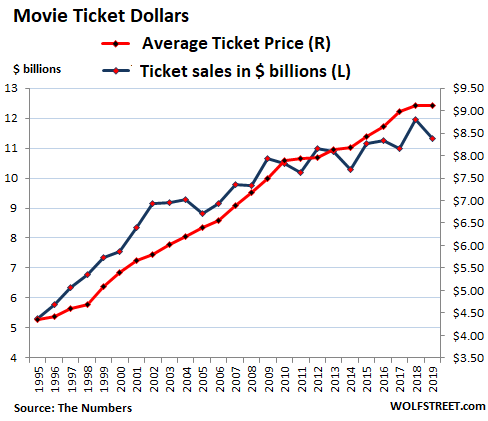Ticket sales plunged 31% per person on average since 2002. You can raise ticket prices only so much before the strategy backfires.
By Wolf Richter for WOLF STREET.
There are many ways to watch movies these days without having to go to a brick-and-mortar movie theater. And it shows. Despite population growth and all the efforts by movie theaters to stay relevant – such as offering extra-comfy chairs and adding bars and allowing people to bring those drinks into the theater – ticket sales continue to zig-zag lower. It seems nothing is working to stem the long-term decline.
Movie ticket sales fell 5.2% in 2019 to 1.244 billion tickets, according to movie data provider The Numbers. This is a 21% plunge from the peak in 2002, when 1.58 billion tickets were sold, and a 14% drop from 20 years ago in 1999, and just a hair above where ticket sales had been in 1995:

On a per-capita basis, ticket sales look a whole lot worse. In 2002, there were 287.6 million people in the US; in 2019, there were 328.2 million people. So on a per-capita basis, ticked sales dropped by 31% from 5.5 tickets per person on average in 2002 to 3.8 tickets per person in 2019.
Streaming services that became popular after the widespread arrival of broadband internet in the early 2000s muscled in on cable TV subscriptions, whose growth began to wither by 2010. And in 2013, cable TV subscriptions began to decline, according to MoffettNathanson data, cited by Bloomberg, and have fallen every year since then, picking up downward momentum along the way, leading to a record year-over-year drop of 6.2% in Q3 2019.
But streaming services, along with increasingly affordable large displays, have also been eating away at movie ticket sales.
Higher ticket prices have been the only factor keeping dollar-revenues at the box office from collapsing in parallel with ticket sales. The average ticket price was $9.11 in 2019, according to estimates by The Numbers, which was more than double the price of an average ticket in 1995 ($4.35).
While $9.11 for a ticket sounds punitively high in some markets, in other markets it’s a hard-to-find deal. For example, at the AMC in San Francisco, a ticket for Jumanji: The Next Level is currently priced at $15.99. Two adults ($15.99 each) and two children ($12.99 each), plus grandma ($14.99) add up to $72.95, not including the sodas and beers from the bar and popcorn. This will easily turn into a $100 event, without doing anything special.
Which is the third factor in the relentless decline of movie ticket sales: this stuff can add up!
Ticket prices rose enough that, despite declining movie ticket sales, box office revenues kept meandering higher, hitting a new record in 2018 of $11.96 billion. Inflation covers a lot of sins. But in 2019, box office receipts dropped 5.3% to $11.33 billion.
The chart below shows average ticket prices (red line, right scale) and box office receipts in billions of dollars (black line, left scale):

The dollars are very concentrated. The six top grossing movies in 2019 were all distributed by Walt Disney. Number eight was also a Walt Disney movie. Those seven combined grossed $3.6 billion, or 31% of the total box office. On average, they each grossed over $500 million. The remaining 661 movies that were shown in theaters in 2019, according to The Numbers, grossed together $7.8 billion, or on average less than $12 million each. Here are the top 20 grossing movies in 2019 (if your smartphone clips the five-column table, slide the table to the left):
| Top 20 Grossing Movies of 2019 | ||||
| Movie | Distributor | Gross, $ millions | Tickets, millions |
|
| 1 | Avengers: Endgame | Walt Disney | $858 | 94.2 |
| 2 | The Lion King | Walt Disney | $544 | 59.7 |
| 3 | Star Wars: The Rise of Skywalker | Walt Disney | $452 | 49.6 |
| 4 | Frozen II | Walt Disney | $450 | 49.4 |
| 5 | Toy Story 4 | Walt Disney | $434 | 47.6 |
| 6 | Captain Marvel | Walt Disney | $427 | 46.9 |
| 7 | Spider-Man: Far From Home | Sony Pictures | $391 | 42.9 |
| 8 | Aladdin | Walt Disney | $356 | 39.0 |
| 9 | Joker | Warner Bros. | $334 | 36.7 |
| 10 | Jumanji: The Next Level | Sony Pictures | $236 | 25.9 |
| 11 | It: Chapter Two | Warner Bros. | $212 | 23.2 |
| 12 | Us | Universal | $175 | 19.2 |
| 13 | Fast & Furious Presents: Hobbs & Shaw | Universal | $174 | 19.1 |
| 14 | John Wick: Chapter 3 — Parabellum | Lionsgate | $171 | 18.8 |
| 15 | How to Train Your Dragon: The Hidden World | Universal | $161 | 17.7 |
| 16 | The Secret Life of Pets 2 | Universal | $158 | 17.4 |
| 17 | Pokémon: Detective Pikachu | Warner Bros. | $144 | 15.8 |
| 18 | Once Upon a Time…in Hollywood | Sony Pictures | $141 | 15.5 |
| 19 | Shazam! | Warner Bros. | $140 | 15.4 |
| 20 | Knives Out | Lionsgate | $130 | 14.3 |
Movie theaters are competing with streaming services that are at least to some extent subsidized by investors, or subsidized by other corporate activities, and stubbornly refuse to generate positive cashflows.
Netflix is the primary example of a perennially cash-flow negative streaming service. It’s easy to see how the cash is getting burned, and how much it has to borrow constantly to keep feeding its cash-burn machine.
The negative cash flows of other top streaming services, such as Hulu (acquired by Walt Disney in 2019), Amazon, and Apple are buried in the vast corporate financial plumbing, and they don’t break out the troublesome details. The companies have other priorities than maximizing cash flow from streaming – including a brutal fight for market share – and they make their money in other activities. These companies can afford to keep the subscription costs low to gain subscribers, even if each subscriber burns cash.
And at $100 a pop for a family outing to the movies, it doesn’t take long to where an annual subscription and watching dozens of movies a year at home on a beautiful big screen makes sense to more and more people.
Broadband has brought structural change to how Americans entertain themselves, how they buy stuff, how they communicate, how they do a million other things. These trends will not miraculously reverse. And raising ticket prices can only paper over structural shifts at brick-and-mortar theaters for so long, before the strategy becomes counterproductive and begins to energize the structural change.